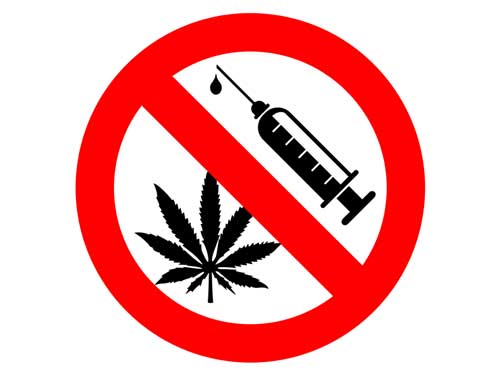




Legislations, policies, guidance and standards regulate and ensure that all members of society follow the law:
The main objective of the Misuse of Drugs Act 1971 is to control the use and circulation of substances deemed dangerous and harmful. Whilst the main principles and framework introduced by the Act remains in force today, there has been important changes in the way society views these substances and the best way to challenge the harm that comes with their misuse. One of the most important changes introduced by the Act was classifying substances (Class A, Class B or Class C) according to the degree of harm from misuse, with determined penalties set for each class. The basic principle of the Act is that it is illegal to possess or distribute a controlled substance, unless a person is licenced by the Home Office to do so.
The Psychoactive Substances Act 2016 is a comparatively new piece of legislation that makes producing, supplying or offering to supply any psychoactive substance, regardless of its potential for harm, illegal. There are some exceptions to the Act, such as substances already controlled by the Misuse of Drugs Act 1971, tobacco, alcohol, caffeine and medicinal products. The primary intention of the Act was to stop the production and distribution of what were termed “legal highs”. Under the Act, possession of a psychoactive substance is not an offence (except in a custodial institution), however, possession with intent to supply is an offence.
The supply of any cigarette lighter refill canister containing butane or a substance with butane as a component to any person under the age of 18 is an offence under the Cigarette Lighter Refill (Safety) Regulations 1999.
The Misuse of Drug Regulations 1973 were produced to protect medical practitioners in prescribing, being in possession of and supplying prescription only substances, such as morphine. The main purpose of the restrictive regulations is to prevent substance abusers and suppliers of controlled medicines from obtaining several prescriptions for controlled medicines from different medical practitioners, thereby accumulating large supplies. An individual can legally possess a drug under these regulations if it has been supplied on a prescription which is correctly written. It is also a requirement of the regulations that a register be kept of every quantity of controlled medicines obtained and every quantity supplied. A record must also be kept of any date of destruction of a controlled drug, the quantity destroyed and must be signed by an authorised person.
COSHH regulations require organisations to control substances that may be hazardous to health. By following COSHH regulations and minimising exposure to hazardous substances (including chemicals, gases, fumes, liquids, and vapours), employees in the organisation and service users are prevented from suffering from the potential health risks associated with these chemicals. The legislation requires organisations to undertake risk assessments in order to identify potentially hazardous substances to which employees and service users may be exposed. For each substance highlighted in the risk assessment, it must be determined whether alternative substances can be used that lessen or eliminate the risk of exposure. This is of particular importance in a setting where substance misuse may be prevalent. If substances must be kept on the premises, security measures must be in place to minimise the risk and potential consequences of service users gaining access. Examples of security measures include lockable cupboards, lockable storage rooms and appropriate training of staff in security measures surrounding storage of substances.
These regulations divide controlled drugs into five schedules equivalent to their therapeutic usefulness and potential misuse and also define the health professionals authorised to possess or supply controlled drugs.
The Code of Professional Practice for Social Care sets out the standards of conduct and criteria to guide practice that employees in social care in Wales are expected to meet in practice. As well as setting out the standards, agreeing to comply with the Code of Professional Practice for Social Care is a requirement of registration. The full Code of Professional Practice for Social Care can be found here:
Mae deddfwriaethau, polisïau, canllawiau a safonau yn rheoleiddio ac yn sicrhau bod pob aelod o'r gymdeithas yn cydymffurfio â'r gyfraith:
Prif amcan Deddf Camddefnyddio Cyffuriau 1971 yw rheoli'r defnydd a'r dosbarthiad o sylweddau yr ystyrir eu bod yn beryglus ac yn niweidiol. Er bod y prif egwyddorion a'r fframwaith a gyflwynwyd gan y Ddeddf yn parhau mewn grym heddiw, bu newidiadau pwysig i farn cymdeithas ar y sylweddau hyn a'r ffordd orau o herio'r niwed sy'n gysylltiedig â'u camddefnyddio. Un o'r newidiadau pwysicaf a gyflwynwyd gan y Ddeddf oedd dosbarthu sylweddau (Dosbarth A, Dosbarth B neu Ddosbarth C) yn ôl graddau'r niwed sy'n gysylltiedig â'u camddefnyddio, gan nodi cosbau penodedig ar gyfer pob dosbarth. Egwyddor sylfaenol y Ddeddf yw ei bod yn anghyfreithlon meddu ar sylwedd rheoledig neu ddosbarthu sylwedd o'r fath, oni bai fod gan berson drwydded gan y Swyddfa Gartref i wneud hynny.
Mae Deddf Sylweddau Seicoweithredol 2016 yn ddarn cymharol newydd o ddeddfwriaeth sy'n ei gwneud hi'n anghyfreithlon i unigolyn gynhyrchu, cyflenwi neu gynnig cyflenwi unrhyw sylwedd seicoweithredol, ni waeth beth fo'i botensial o ran niwed. Ceir rhai eithriadau i'r Ddeddf, megis sylweddau a gaiff eu rheoli eisoes gan Ddeddf Camddefnyddio Cyffuriau 1971, tybaco, alcohol, caffein a chynhyrchion meddyginiaethol. Prif fwriad y Ddeddf oedd atal unigolion rhag cynhyrchu a dosbarthu cyffuriau y cyfeirir atynt fel "anterth cyfreithlon". O dan y Ddeddf, nid yw'n drosedd meddu ar sylwedd seicoweithredol (ac eithrio mewn carchar), ond mae'n drosedd meddu ar sylwedd o'r fath gyda'r bwriad o'i gyflenwi.
O dan Reoliadau Ail-lenwi Tanwyr Sigaréts (Diogelwch) 1999, mae'n drosedd cyflenwi unrhyw gynhwysydd ail-lenwi tanwyr sigaréts sy'n cynnwys biwtan neu sylwedd â biwtan yn rhan ohono i unrhyw berson o dan 18 oed.
Lluniwyd Rheoliadau Camddefnyddio Cyffuriau 1973 er mwyn amddiffyn ymarferwyr meddygol wrth iddynt ragnodi sylweddau a gynigir ar bresgripsiwn yn unig, megis morffin, meddu ar sylweddau o'r fath a'u cyflenwi. Prif ddiben y rheoliadau cyfyngol hyn yw atal unigolion sy'n camddefnyddio sylweddau a chyflenwyr meddyginiaethau rheoledig rhag cael gafael ar sawl presgripsiwn ar gyfer meddyginiaethau rheoledig gan wahanol ymarferwyr meddygol, gan felly gronni cyflenwadau mawr. Gall unigolyn feddu ar gyffur yn gyfreithlon o dan y rheoliadau hyn os bydd y cyffur hwnnw wedi'i gyflenwi ar bresgripsiwn wedi'i ysgrifennu'n briodol. Mae'r rheoliadau hefyd yn ei gwneud hi'n ofynnol cadw cofrestr o bob dogn o feddyginiaeth reoledig a geir a phob dogn a gyflenwir. Rhaid hefyd cadw cofnod o unrhyw ddyddiad y caiff cyffur rheoledig ei ddinistrio, faint a ddinistriwyd a rhaid i berson awdurdodedig lofnodi'r cofnod hwnnw.
Mae rheoliadau COSHH yn ei gwneud hi'n ofynnol i sefydliadau reoli sylweddau a all fod yn beryglus i iechyd. Drwy ddilyn rheoliadau COSHH a lleihau amlygiad i sylweddau peryglus (gan gynnwys cemegion, nwyon, mygdarthau, hylifau, ac anweddau), caiff gweithwyr yn y sefydliad a defnyddwyr gwasanaethau eu diogelu rhag y risgiau posibl i iechyd sy'n gysylltiedig â'r cemegion hyn. Mae'r ddeddfwriaeth yn ei gwneud hi'n ofynnol i sefydliadau gynnal asesiadau risg er mwyn nodi sylweddau a all fod yn beryglus y gall gweithwyr a defnyddwyr gwasanaethau o bosibl ddod i gysylltiad â nhw. Ar gyfer pob sylwedd a nodir yn yr asesiad risg, rhaid penderfynu p'un a ellir defnyddio sylweddau amgen sy'n lleihau neu'n dileu'r risg y daw pobl i gysylltiad â nhw. Mae hyn yn bwysig iawn mewn lleoliad lle y ceir achosion mynych o gamddefnyddio sylweddau. Os oes yn rhaid cadw sylweddau ar y safle, rhaid rhoi mesurau diogelwch ar waith i leihau'r risg a'r canlyniadau posibl os bydd defnyddwyr gwasanaethau yn cael mynediad iddynt. Mae enghreifftiau o fesurau diogelwch yn cynnwys cypyrddau y gellir eu cloi, ystafelloedd storio y gellir eu cloi a chynnig hyfforddiant mesurau diogelwch priodol i'r staff mewn perthynas â storio sylweddau.
Mae'r rheoliadau hyn yn rhannu cyffuriau rheoledig i bum atodlen yn seiliedig ar eu defnyddioldeb therapiwtig a'r potensial i'w camddefnyddio ac maent hefyd yn diffinio'r gweithwyr iechyd proffesiynol sydd ag awdurdod i feddu ar gyffuriau rheoledig neu eu cyflenwi.
Mae'r Cod Ymarfer Proffesiynol ar gyfer Gofal Cymdeithasol yn nodi'r safonau ymddygiad a'r meini prawf i dywys yr ymarfer y disgwylir i weithwyr ym maes gofal cymdeithasol yng Nghymru ei roi ar waith. Yn ogystal â nodi'r safonau, mae cytuno i gydymffurfio â'r Cod Ymarfer Proffesiynol ar gyfer Gofal Cymdeithasol yn ofyniad cofrestru. Gellir gweld y Cod Ymarfer Proffesiynol llawn ar gyfer Gofal Cymdeithasol yma:

Alcohol is an easily available substance that contains ethanol.
In its purest form, alcohol is a clear liquid. What it looks like when purchased depends on what and how many other liquids and colourings have been added to it.
Alcohol is not covered by the Misuse of Drugs Act 1971, however, in the UK it is an offence to:
There is an exception of purchasing alcohol at a pub for 16 and 17 year olds with a table meal and accompanied by an adult.
Mae alcohol yn sylwedd sydd ar gael yn hawdd ac mae'n cynnwys ethanol.
Ar eu ffurf buraf, hylif clir yw alcohol. Mae ei olwg pan gaiff ei brynu yn dibynnu ar ba hylifau a lliwiau eraill a faint ohonynt a ychwanegwyd ato.
Nid yw Deddf Camddefnyddio Cyffuriau 1971 yn berthnasol i alcohol, ond, yn y DU, mae'n drosedd gwneud y canlynol:
Mae yna eithriad wrth brynu alcohol mewn tafarn ar gyfer pobl ifanc 16 ac 17 oed os fyddant yn bwyta pryd wrth y bwrdd gydag oedolyn.

Cannabis is considered to be a Class B drug under The Misuse of Drugs Act 1971.
Cannabis can be seen in four forms:
The effects experienced vary depending on the dose, method of administration, prior experiences of using cannabis and mood of the user. The effects of cannabis may be felt within minutes and may linger for two or three hours after administration. The user may experience:
The main active chemical in cannabis is tetrahydrocannabinol (THC) which is a psychoactive that can have various short-term risks on the brain causing:
Long-term risks of cannabis use can include:
Cannabis can be ingested via smoking the herbal cannabis, inhaling via a pipe, a bong or by using an e-cigarette, and by eating or drinking mixed into cakes or brewed with tea or alcohol.
Ystyrir bod canabis yn gyffur Dosbarth B o dan Ddeddf Camddefnyddio Cyffuriau 1971.
Mae canabis yn ymddangos mewn pedair ffurf:
Mae'r effeithiau a brofir yn amrywio gan ddibynnu ar y dogn, y ffordd o'i gymryd, profiadau blaenorol o ddefnyddio canabis a hwyliau'r defnyddiwr. Gellir teimlo effeithiau canabis o fewn munudau a gallant barhau am ddwy neu dair awr ar ôl cymryd y cyffur. Gall y defnyddiwr brofi'r canlynol:
Y prif gemegyn gweithredol mewn canabis yw tetrahydrocannabinol (THC), sef cyffur seicoweithredol a all achosi amrywiol risgiau byrdymor mewn perthynas â'r ymennydd, gan achosi:
Gall risgiau hirdymor canabis gynnwys y canlynol:
Gellir llyncu canabis drwy smygu canabis llysieuol, ei fewnanadlu drwy bibell, bong neu drwy ddefnyddio e-sigarét, a thrwy ei fwyta neu ei yfed wedi'i gymysgu i mewn i gacennau neu mewn te neu alcohol.

Cocaine is considered to be a Class A drug under The Misuse of Drugs Act 1971.
Cocaine usually comes in a fine white powder.
Cocaine is a fast-acting nervous system stimulant lasting from 15-90 minutes that may cause:
As cocaine is a stimulant, using this substance has an effect on the brain and its functions in controlling body systems.
Short-term risks of using cocaine may include:
Long-term risks of cocaine use are more noticeable as tolerance to the substance will increase very quickly which means increased abuse. Long-term risks may include:
As a Class A substance, cocaine carries a maximum sentence of 7 years and/or an unlimited fine for possession and a life sentence and/or fine for supply.
Ystyrir bod cocên yn gyffur Dosbarth A o dan Ddeddf Camddefnyddio Cyffuriau 1971.
Daw cocên fel arfer ar ffurf powdwr gwyn mân.
Mae cocên yn adfywiwr sy'n gweithredu'n gyflym ar y system nerfol ac yn para rhwng 15 a 90 munud. Gall achosi'r canlynol:
Gan mai cyffur adfywiol yw cocên, wrth ddefnyddio'r sylwedd hwn, ceir effaith ar yr ymennydd a'i swyddogaethau wrth reoli systemau'r corff.
Gall risgiau byrdymor defnyddio cocên gynnwys y canlynol:
Mae risgiau hirdymor defnyddio cocên yn fwy amlwg gan y bydd goddefedd tuag at y sylwedd yn cynyddu'n gyflym iawn sy'n golygu y bydd unigolion yn ei gamddefnyddio mwy. Gall risgiau hirdymor gynnwys y canlynol:
Fel sylwedd Dosbarth A, ceir uchafswm dedfryd o 7 mlynedd a/neu ddirwy ddigyfyngiad am feddu ar gocên a dedfryd am oes a/neu ddirwy am ei gyflenwi.

Amphetamines are usually seen as grey, pink or yellow crystal-like powders, pills or pastes.
Amphetamines are powerful stimulants of the central nervous system. As a recreational substance, amphetamine can lead to:
Amphetamines can cause significant risks such as:
There are various routes of administrating amphetamine:
As a Class A substance, recreational use of amphetamine (without a prescription) carries a maximum sentence of 7 years and/or an unlimited fine for possession and a life sentence and/or fine for supply.
Daw amffetaminau fel arfer ar ffurf pils, pastau neu bowdrau crisialog llwyd, pinc neu felyn.
Mae amffetaminau yn gyffuriau adfywio cryf sy'n effeithio ar y system nerfol ganolog. Fel sylwedd hamdden, gall amffetaminau arwain at:
Gall amffetaminau achosi risgiau sylweddol fel:
Mae amrywiol ffyrdd o gymryd amffetaminau:
Fel sylwedd Dosbarth A, ceir uchafswm dedfryd o 7 mlynedd a/neu ddirwy ddigyfyngiad am ddefnydd hamdden o amffetamin (heb bresgripsiwn) a dedfryd am oes a/neu ddirwy am ei gyflenwi.

Heroin is an opiate considered to be a Class A drug under The Misuse of Drugs Act 1971.
Pure heroin (diacetylmorphine, a semi-synthetic imitative of morphine) is found as a white powder. However, as it may be cut with a variety of different substances, the colour of heroin on sale in the UK ranges from a beige to a dark brown.
Heroin breaks down in the body into morphine and other substances which quickly bind to receptor sites in the brain causing:
It is extremely easy to overdose on heroin due to depression of the central nervous system. Heroin is also very often “cut” or contaminated with other potentially dangerous substances when ingested or other strong opioids. Associated risks of abusing heroin can include:
Heroin is most commonly dissolved in water and heated before being injected intravenously; when this method of administration is used, the user will start to feel the effects immediately. It may also be administered through:
As a Class A substance, heroin carries a maximum sentence of 7 years and/or an unlimited fine for possession and a life sentence and/or fine for supply.
Mae heroin yn opiad yr ystyrir ei fod yn gyffur Dosbarth A o dan Ddeddf Camddefnyddio Cyffuriau 1971.
Daw heroin pur (diacetylmorphine, cyffur lled-synthetig sy'n dynwared morffin) ar ffurf powdwr gwyn. Fodd bynnag, gellir ei gymysgu ag amrywiaeth o wahanol sylweddau, felly mae lliw yr heroin sydd ar werth yn y DU yn amrywio o lwydfelyn i frown tywyll.
Yn y corff, mae heroin yn dadelfennu'n forffin ac yn sylweddau eraill sy'n rhwymo'n gyflym i safleoedd derbyn yr ymennydd gan achosi'r canlynol:
Mae'n hawdd iawn cymryd dos gormodol o heroin gan ei fod yn llethu'r system nerfol ganolog. Caiff heroin hefyd ei gymysgu neu ei halogi â sylweddau eraill a all fod yn beryglus pan gânt eu llyncu neu opioidau cryf eraill. Gall y risgiau sy'n gysylltiedig â chamddefnyddio heroin gynnwys y canlynol:
Caiff heroin ei hydoddi mewn dŵr fel arfer a'i wresogi cyn ei chwistrellu drwy wythïen; pan ddefnyddir y dull hwn o gymryd y cyffur, bydd y defnyddiwr yn dechrau teimlo'r effeithiau ar unwaith. Gellir hefyd ei gymryd drwy:
Fel sylwedd Dosbarth A, ceir uchafswm dedfryd o 7 mlynedd a/neu ddirwy ddigyfyngiad am feddu ar heroin a dedfryd am oes a/neu ddirwy am ei gyflenwi.

Solvent and gases are mostly common household products that abusers use to reach a high.
Solvents and gases are found in many household products, such as:
Solvents and gases act as depressants slowing down activity of the central nervous system leading to a feeling similar to the effects to alcohol.
As most of the solvents and gases commonly abused are household products available to purchase off-the-shelf, many are under the assumption that they are safe to use. However, abusing solvents and gases can cause:
Solvents and gases give off a vapour that can be inhaled through the mouth or nose to give the desired effect to the user. These vapours can be directly inhaled from the container, inhaled from a plastic or paper bag or inhaled from a piece of cloth soaked in the substance.
Solvents and gases are not illegal in the UK. However, it is illegal to sell petrol to any person under the age of 16 or to supply gas lighter refills to anyone under the age of 18.
Fel arfer, defnyddir hydoddyddion a nwyon a geir ar ffurf cynhyrchion cartref cyffredin gan unigolion sy'n camddefnyddio sylweddau er mwyn cael effaith anterthol.
Mae hydoddyddion a nwyon i'w cael mewn llawer o gynhyrchion cartref, fel:
Mae hydoddyddion a nwyon yn gweithredu fel iselyddion gan arafu gweithgarwch y system nerfol ganolog, gan arwain at deimlad tebyg i effeithiau alcohol.
Gan mai cynhyrchion cartref yw'r rhan fwyaf o'r toddyddion a'r nwyon a gaiff eu camddefnyddio amlaf a'u bod ar gael i'w prynu oddi ar y silff, mae llawer yn cymryd yn ganiataol eu bod yn ddiogel i'w defnyddio. Fodd bynnag, gall camddefnyddio hydoddyddion a nwyon achosi'r canlynol:
Mae hydoddyddion a nwyon yn creu anwedd y gellir ei fewnanadlu drwy'r geg neu'r trwyn er mwyn i'r defnyddiwr brofi'r effaith ddymunol. Gellir mewnanadlu'r anweddau hyn yn uniongyrchol o'r cynhwysydd, eu mewnanadlu o fag plastig neu bapur neu eu mewnanadlu o ddarn o frethyn wedi'i fwydo â'r sylwedd.
Nid yw hydoddyddion a nwyon yn anghyfreithlon yn y DU. Fodd bynnag, mae'n anghyfreithlon gwerthu petrol i unrhyw berson o dan 16 oed neu i werthu cynhyrchion ail-lenwi tanwyr nwy i unrhyw un o dan 18 oed.

Benzodiazepines are a class of drugs that act on the central nervous systems. They are commonly prescribed as a sedative to treat a range of conditions such as anxiety, panic disorders, insomnia, seizures and alcohol withdrawal.
Benzodiazepines come in tablet, capsule, injection or suppository form.
Benzodiazepines induce a sedative effect of calmness, relaxation and sleep. They are often taken as a chill-out drug to aid in the down effects following abuse of stimulants.
In addition to dependency, the risks of taking benzodiazepines include:
Although benzodiazepines come in the form of tablets, capsules, and suppositories, which can be easily ingested, some abusers will crush the tablets or melt the capsules in order to make them easier to be injected intravenously.
Benzodiazepines are Prescription Only Medicines (POMs) under the Medicines Act 1968.
They are also considered to be a Class C drug under The Misuse of Drugs Act 1971. Under the Misuse of Drugs Act it is an offence to produce, supply, offer to supply, possess with intent to supply, possess on custodial premises and import or export benzodiazepines, carrying a maximum sentence of 7 years and/or an unlimited fine.
Mae bensodiasepinau yn ddosbarth o gyffuriau sy'n gweithredu ar y systemau nerfol canolog. Fel arfer, cânt eu rhagnodi fel tawelydd i drin amrywiaeth o gyflyrau fel gorbryder, anhwylderau panig, anhunedd, trawiadau a symptomau diddyfnu mewn perthynas ag alcohol.
Daw bensodiasepinau ar ffurf tabled, capsiwl, chwistrelliad neu dawddgyffur.
Mae bensodiasepinau yn creu effaith dawelu ac yn arwain at deimladau o lonyddwch, ymlacio a chwsg. Cânt eu cymryd yn aml fel cyffur ymlacio er mwyn hwyluso'r effeithiau negyddol sy'n gysylltiedig â'r cyfnod yn union ar ôl camddefnyddio cyffuriau adfywiol.
Yn ogystal â dibyniaeth, mae'r risgiau sy'n gysylltiedig â chymryd bensodiasepinau yn cynnwys y canlynol:
Er bod bensodiasepinau ar gael ar ffurf tabledi, capsiwlau a thawddgyffuriau, y gellir eu llyncu'n hawdd, bydd rhai unigolion sy'n eu camddefnyddio yn malu'r tabledi neu'n toddi'r capsiwlau er mwyn ei gwneud yn haws i'w chwistrellu drwy wythïen.
Mae bensodiasepinau yn Feddyginiaethau ar Bresgripsiwn yn Unig (POM) o dan Ddeddf Meddyginiaethau 1968.
Fe'u hystyrir hefyd yn gyffur Dosbarth C o dan Ddeddf Camddefnyddio Cyffuriau 1971. O dan Ddeddf Camddefnyddio Cyffuriau, mae’n drosedd cynhyrchu bensodiasepinau, eu cyflenwi, cynnig eu cyflenwi, meddu arnynt â'r bwriad o gyflenwi, meddu arnynt mewn carchar a'u mewnforio neu eu hallforio, a cheir uchafswm dedfryd o 7 mlynedd a/neu ddirwy ddiderfyn am wneud hynny.

Synthetic cannabinoids are chemicals produced to mimic the main psychoactive chemicals found naturally in cannabis. Synthetic cannabinoids are part of a group of drugs known as new psychoactive substances (NPS).
Synthetic cannabinoids are either in the form of solids or oils. The chemicals are sprayed onto dried plant materials. The mixtures are packaged in small parcels to be sold.
Synthetic cannabinoids act on the central nervous system in the same way as the ingredients in cannabis.
As the chemical make-up of synthetic cannabinoids is constantly varying, the effects are often unpredictable and produce a much stronger effect. As a result, it is much harder for the user to gauge the amount to be taken.
Synthetic cannabinoids can be administered in similar ways to cannabis:
In addition, as e-cigarettes have become more available, e-liquids containing synthetic cannabinoids have been produced.
Synthetic cannabinoids are classed as psychoactive substances and are therefore controlled under the Psychoactive Substances Act 2016. There is currently no penalty for possession, however, supply and production will carry a maximum sentence of 7 years.
Mae canabinoidau synthetig yn gemegion a gynhyrchir i ddynwared y prif gemegion seicoweithredol a geir yn naturiol mewn canabis. Mae canabinoidau synthetig yn rhan o grŵp o gyffuriau y cyfeirir atynt fel sylweddau seicoweithredol newydd (NPS).
Daw canabinoidau synthetig naill ai ar ffurf solet neu olew. Caiff y cemegion eu chwistrellu ar ddeunydd planhigion sych. Caiff y cymysgeddau eu pecynnu'n barseli bach i'w gwerthu.
Mae canabinoidau synthetig yn gweithredu ar y system nerfol ganolog yn yr un ffordd â'r cynhwysion mewn canabis.
Gan fod cyfansoddiad cemegol canabinoidau synthetig yn amrywio’n gyson, mae'r effeithiau yn aml yn annisgwyl ac yn cael effaith lawer cryfach. O ganlyniad, mae'n llawer anoddach i'r defnyddiwr benderfynu faint i'w gymryd.
Gellir cymryd canabinoidau synthetig mewn ffyrdd tebyg i ganabis:
Yn ogystal, gan fod e-sigaréts yn fwy cyffredin erbyn hyn, cynhyrchwyd e-hylifau sy'n cynnwys canabinoidau synthetig.
Caiff canabinoidau synthetig eu dosbarthu fel sylweddau seicoweithredol ac fe'u rheolir felly o dan Ddeddf Sylweddau Seicoweithredol 2016. Ar hyn o bryd, nid oes unrhyw gosb am feddu arnynt, ond ceir uchafswm dedfryd o 7 mlynedd am eu cyflenwi a'u cynhyrchu.

Ketamine is a hallucinogenic dissociative substance and considered to be a Class B drug under the Misuse of Drugs Act 1971.
When used in medicine for anaesthetic purposes, ketamine is supplied as a clear liquid. For recreational purposes, it is supplied as a grainy white or brown crystalline powder or, more rarely, as tablets.
The effects of recreational ketamine can begin within a few minutes of administration. In addition to reducing sensations in the body, Ketamine will also give the user a feeling of being in a dream-like state, a feeling of euphoria and a feeling of painlessness.
Risks of taking ketamine include:
Recreational ketamine is administered via:
As a Class B substance, ketamine carries a maximum sentence of 5 years and/or an unlimited fine for possession and a 14 year maximum sentence and/or unlimited fine for supply.
Mae cetamin yn sylwedd datgysylltiol rhithbair ac fe'i ystyrir yn gyffur Dosbarth B o dan Ddeddf Camddefnyddio Cyffuriau 1971.
Pan gaiff ei ddefnyddio mewn meddygaeth at ddibenion anaesthetig, caiff cetamin ei gyflenwi ar ffurf hylif clir. At ddibenion hamdden, caiff ei gyflenwi fel powdwr crisialog gronynnog gwyn neu frown neu weithiau ar ffurf tabledi.
Gall effeithiau cetamin ar ffurf hamdden ddechrau o fewn ychydig funudau o'i gymryd. Yn ogystal â lleihau gallu'r corff i synhwyro, bydd cetamin hefyd yn rhoi ymdeimlad o fod mewn cyflwr breuddwydiol, teimlad o ewfforia a theimlad o ddiffyg poen i'r defnyddiwr.
Mae'r risgiau sy'n gysylltiedig â chymryd cetamin yn cynnwys y canlynol:
Caiff cetamin ar ffurf hamdden ei gymryd drwy:
Fel sylwedd Dosbarth B, ceir uchafswm dedfryd o 5 mlynedd a/neu ddirwy ddigyfyngiad am feddu ar cetamin ac uchafswm dedfryd o 14 mlynedd a/neu ddirwy ddigyfyngiad am ei gyflenwi.

MDMA is a psychoactive substance considered to be a Class A drug under the Misuse of Drugs Act 1971.
MDMA is a substance available in tablet or powder form. Tablets can be white, coloured, round, square or pressed into any shape. Some tablets have designs stamped onto the surface, such as logos and pictures. MDMA powder comes as a white/grey crystalline powder.
The effects produced by MDMA are energising, alter perceptions and enhance tactile experiences by stimulating the effects of neurotransmitters, such as serotonin, in the brain.
The strength of MDMA is unpredictable and therefore the associated risks can vary. Some risks include:
MDMA may be taken in:
As a Class A substance, MDMA carries a maximum sentence of 7 years and/or an unlimited fine for possession and a life sentence and/or fine for supply.
Mae MDMA yn sylwedd seicoweithredol yr ystyrir ei fod yn gyffur Dosbarth A o dan Ddeddf Camddefnyddio Cyffuriau 1971.
Mae MDMA yn sylwedd sydd ar gael ar ffurf tabled neu bowdwr. Gall tabledi fod yn wyn, yn lliw, yn grwn, yn sgwâr neu wedi'u gwasgu i greu unrhyw siâp. Mae gan rai tabledi ddyluniadau wedi'u stampio ar yr wyneb, megis logos a lluniau. Daw powdwr MDMA ar ffurf powdwr crisialog gwyn/llwyd.
Mae'r effeithiau a gynhyrchir gan MDMA yn rhoi egni, yn newid canfyddiadau ac yn gwella profiadau cyffyrddol drwy ysgogi effeithiau niwrodrosglwyddyddion, fel serotonin, yn yr ymennydd.
Mae cryfder MDMA yn anodd ei ragweld ac felly gall y risgiau cysylltiedig amrywio. Mae rhai o'r risgiau yn cynnwys y canlynol:
Gellir cymryd MDMA fel a ganlyn:
Fel sylwedd Dosbarth A, ceir uchafswm dedfryd o 7 mlynedd a/neu ddirwy ddigyfyngiad am feddu ar MDMA a dedfryd am oes a/neu ddirwy am ei gyflenwi.

Image and performance enhancing drugs are Class C drugs taken to build muscles or improve sports performance by mimicking the effects of the testosterone hormone.
Image and performance enhancing drugs are available as tablets or as a liquid for injection.
It is claimed that image and performance enhancing drugs enable individuals to train harder and longer, assist in recovery from strenuous exercise and assist in building body mass.
The risks of taking image and performance enhancing drugs include:
In males, the risks of taking image and performance enhancing drugs include:
In females, the risks of taking image and performance enhancing drugs include:
Image and performance enhancing drugs are available as tablets or as a liquid for intramuscular (IM) injection.
As Class C substances, image and performance enhancing drugs carry a maximum sentence of 2 years and/or an unlimited fine for possession and a 14 year sentence and/or fine for supply.
Anabolic Steroids (IPEDS) are not illegal to possess but illegal to produce and supply.
Mae cyffuriau sy'n gwella delwedd a pherfformiad yn gyffuriau Dosbarth C a gymerir er mwyn magu cyhyrau neu wella perfformiad chwaraeon drwy ddynwared effeithiau'r hormon testosteron.
Mae cyffuriau sy'n gwella delwedd a pherfformiad ar gael ar ffurf tabledi neu ar ffurf hylif i'w chwistrellu.
Honnir bod cyffuriau sy'n gwella delwedd a pherfformiad yn galluogi unigolion i hyfforddi'n galetach ac am gyfnodau hirach, eu bod yn helpu i wella ar ôl cyfnodau o ymarfer corff caled a'u bod yn helpu i gynyddu màs y corff.
Mae'r risgiau sy'n gysylltiedig â chymryd cyffuriau sy'n gwella delwedd a pherfformiad yn cynnwys y canlynol:
Mewn dynion, mae'r risgiau sy'n gysylltiedig â chymryd cyffuriau sy'n gwella delwedd a pherfformiad yn cynnwys y canlynol:
Mewn menywod, mae'r risgiau sy'n gysylltiedig â chymryd cyffuriau sy'n gwella delwedd a pherfformiad yn cynnwys y canlynol:
Mae cyffuriau sy'n gwella delwedd a pherfformiad ar gael ar ffurf tabledi neu ar ffurf hylif i'w chwistrellu i mewn i gyhyr.
Fel sylwedd Dosbarth C, ceir uchafswm dedfryd o 2 flynedd a/neu ddirwy ddigyfyngiad am feddu ar gyffuriau sy'n gwella delwedd a pherfformiad a dedfryd o 14 mlynedd a/neu ddirwy am eu cyflenwi.
Nid yw cael Steroidau Anabolig (IPEDS) yn eich meddiant yn anghyfreithlon ond mae’n anghyfreithlon i’w cynhyrchu a’u cyflenwi.

Stimulants (also known as psychostimulants) is a term for substances that increase the activity of the central nervous system, i.e. the brain and the spinal cord, and increase heart rate. These substances will temporarily increase awareness and energy and, as such, can be considered as performance enhancers.
Depressants have the direct opposite effects to stimulants in that they slow down the activity of the central nervous system, heart rate and breathing. These substances will slow down activity and induce drowsiness, relaxation, decreased inhibition and sleep.
Analgesics are painkillers used to provide relief from pain. They act temporarily on the central and peripheral nervous systems. Non-opioid analgesics, such as over-the-counter paracetamol or aspirin, are suitable to take for relief of mild pain. Opioid analgesics are stronger, are largely not available over-the-counter and are suitable for temporary relief of moderate to severe pain.
Hallucinogens are also known as psychoactive agents that alter thought processes where users may hear sounds, see images or feel sensations that may appear to be real but are not.
Mae symbylyddion (y cyfeirir atynt hefyd fel seicosymbylyddion) yn derm am sylweddau sy'n cynyddu gweithgarwch y system nerfol ganolog, h.y. yr ymennydd a madruddyn y cefn, ac yn cynyddu curiad y galon. Bydd y sylweddau hyn yn cynyddu ymwybyddiaeth ac egni am gyfnod byr ac, fel y cyfryw, gellir eu hystyried yn gyffuriau gwella perfformiad.
Mae effaith iselyddion yn gwbl groes i effaith symbylyddion, yn yr ystyr eu bod yn arafu gweithgarwch y system nerfol ganolog, curiad y galon a'r gyfradd anadlu. Bydd y sylweddau hyn yn arafu gweithgarwch ac yn arwain at flinder, ymlacio, llai o ataliad a chwsg.
Mae poenleddfwyr yn cael eu defnyddio i ddarparu rhyddhad rhag poen. Maent yn gweithredu dros dro ar y system nerfol ganolog a'r system nerfol berifferol. Mae poenleddfwyr nad ydynt yn opioidau, megis paracetamol neu aspirin y gellir eu cael dros y cownter, yn addas i'w cymryd i ryddhau poen ysgafn. Mae poenleddfwyr opioid yn gryfach, ac yn gyffredinol nid ydynt ar gael dros y cownter. Maent yn addas i roi rhyddhad dros dro rhag poen cymedrol i ddifrifol.
Cyfeirir at rithbeiriau hefyd fel cyfryngau seicoweithredol sy'n newid prosesau meddwl lle y gall defnyddwyr glywed synau, gweld delweddau neu deimlo synhwyrau a all ymddangos yn real ond nad ydynt yn real.

Experimental substance misuse is the first step in substance misuse when a person starts to explore and experiment with substances. Experimental substance misuse is usually a passing period of light substance abuse, usually occurring in adolescence and young adulthood, that does not progress to regular use. Experimental substance misuse may be seen as a way to fit in and socialise with other people and to build a social group. In most cases, individuals will be cautious about the substances that they take, and the quantities of substances taken.
Recreational substance misuse refers to the casual or social use of substances for enjoyment, usually starting as a way to provide pleasure or improve social life. Alcohol and tobacco are the two most common legally available substances misused; cannabis is the most common illegal substance misused, followed by cocaine.
Dependent / problematic substance misuse develops from repeated substance use that results in withdrawal symptoms upon stopping use. Dependence may include the user’s increase in tolerance, withdrawal syndrome, unsuccessful attempts at cutting down frequency of use or stopping altogether and losing of control of usage.
Camddefnyddio sylweddau mewn ffordd arbrofol yw'r cam cyntaf wrth gamddefnyddio sylweddau, pan fydd person yn dechrau archwilio ac arbrofi â sylweddau. Fel arfer, cyfnod byr o gamddefnyddio sylweddau ysgafn fydd y cam camddefnyddio sylweddau mewn ffordd arbrofol, a fydd yn digwydd fel arfer yn ystod y glasoed ac ymhlith oedolion ifanc, ac na fydd yn datblygu i ddefnydd rheolaidd. Gellir ystyried y cam camddefnyddio sylweddau mewn ffordd arbrofol fel ffordd o deimlo'n rhan a chymdeithasu â phobl eraill ac o ddatblygu grŵp cymdeithasol. Yn y rhan fwyaf o achosion, bydd unigolion yn ofalus o ran pa sylweddau y byddant yn eu cymryd, a faint y byddant yn ei gymryd.
Mae camddefnyddio sylweddau at ddibenion hamdden yn cyfeirio at ddefnydd achlysurol neu gymdeithasol o sylweddau er boddhad, gan ddechrau fel arfer fel ffordd o gynnig pleser neu wella bywyd cymdeithasol. Alcohol a thybaco yw'r ddau sylwedd mwyaf cyffredin sydd ar gael yn gyfreithiol a gamddefnyddir; canabis yw'r sylwedd anghyfreithiol mwyaf cyffredin a gamddefnyddir, wedi'i ddilyn gan gocên.
Mae camddefnyddio sylweddau mewn ffordd ddibynnol / broblematig yn datblygu pan fydd unigolion yn camddefnyddio sylweddau dro ar ôl tro, gan arwain at symptomau diddyfnu pan fyddant yn rhoi'r gorau iddynt. Gall dibyniaeth gynnwys cynnydd yn lefel goddefiad y defnyddiwr, syndrom diddyfnu, ymdrechion aflwyddiannus i'w defnyddio llai neu i roi'r gorau iddynt yn llwyr a cholli rheolaeth dros y defnydd ohonynt.

Substance misuse refers to:
The term often refers to illegal substances, however, legal substances are also very often misused, such as alcohol and prescription medicines.
Substance misuse may include experimental, recreational and dependent and/or problematic use of substances which have been obtained legally, illegally, acquired with or without prescription and may be used singularly or in any combination with other substances.
Mae camddefnyddio sylweddau yn cyfeirio at:
Mae'r term yn aml yn cyfeirio at sylweddau anghyfreithlon, ond caiff sylweddau cyfreithiol yn aml eu camddefnyddio hefyd, fel alcohol a meddyginiaethau ar bresgripsiwn.
Gall camddefnyddio sylweddau gynnwys defnydd arbrofol, hamdden a dibynnol a/neu broblematig o sylweddau a gafwyd yn gyfreithiol, yn anghyfreithlon, gyda phresgripsiwn neu heb bresgripsiwn a gellir defnyddio sylweddau unigol neu gyfuniad o sylweddau gyda'i gilydd.